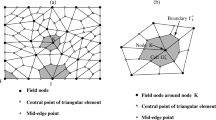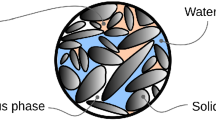One of the most functional standard numerical methods for studying of material deformation and failure is the finite element method (FEM). In some cases, the FEM method cannot perform well in the simulation of some behaviors of rocks and soils due to tangling of the meshing process even in the case of employing the updated Lagrangian method. Researches indicate that the smoothed particle hydrodynamic arising from the fast development, computational sophistication, and emergence of mesh-less particle modeling techniques present proper solutions for problems that cannot be simulated by traditional finite analytical techniques. The advantages of applying this method are simplicity of concept, relative simplicity in combination with modern physics, and particularly its potential in the study of large deformations and failures. This work deals with the advances in this mesh-free technique for numerical analysis and modeling of soil and rock failure.
Similar content being viewed by others
References
L. Lucy, "A numerical approach to testing the fission hypothesis," Astron. J., 82, 1013-1024 (1977).
R. A. Gingold and J. J. Monaghan, "Smoothed particle hydrodynamics: theory and application to non-spherical stars," Mon. Not. Roy. Astron. Soc., 181, 375-389 (1977).
L. D. Libersky and A.G. Petschek, "Smoothed particle hydrodynamics with strength of materials," Proc. of the Next Free Lagrange Conference, Springer, New York., 395, 248-257 (1991).
J. J. Monaghan, "Simulating free surface flows with SPH," J. Comput. Phys., 110, 399-406 (1994).
W. Benz, and E. Asphaig, "Explicit 3d continuum fracture modeling with smoothed particle hydrodynamics," Proc. of 24th Lunar and Planetary Science Conference, 99-100 (1993).
R. Das and P.W. Clearly, "Effect of rock shapes on brittle fracture using Smoothed Particle Hydrodynamics," Theor. Appl. Fracture Mech., 53, 47-60 (2010).
R. Das, and P.W. Clearly, "Simulating brittle fracture of rocks using smoothed particle hydrodynamics," Current Themes in Engineering Science (2008).
G. W. MA, X. J. Wang, and Q. M. Li, "Modeling strain rate effect of heterogeneous materials using SPH method," Rock Mech. Rock Eng., 43(6), 763-776 (2010).
W. Chen, "Numerical studies of seismically induced slope deformation using smoothed particle hydrodynamics method," The Pennsylvania State University (2012).
W. Chen and T. Qui, "Simulation of earthquake-induced slope deformation using SPH method," Geo-Congress, ASCE (2012).
H. H. Bui, R. Fukagawa, and K. Sako, "Slope stability analysis and discontinuous slope failure simulation by elasto-plastic smoothed particle hydrodynamics (SPH)," Geotechnique, 61(7), 565-574 (2011).
Y. Ono, "SPH simulation of earthquake-induced slope failure," 15th World Congress on Earthquake Eng (2012).
D. Deb and R. Pramanik, "Failure process of brittle rock using smoothed particle hydrodynamics," J. Eng. Mech., 139(11), 1551-1565 (2013).
R. Pramanik and D. Deb, "Rock failure analysis using smoothed-particle hydrodynamics," Geosys. Eng., 16(1). 92-99 (2013).
T. Blanc, and M. Pastor, "Towards SPH modelling of failure problems in geo-mechanics: a fractional step Taylor-SPH model," Eur. J. Environ. Civil Eng., 15(1), 31-49 (2011).
T. Blanc and M. Pastor, "A stabilized Fractional Step, Runge-Kutta Taylor SPH algorithm for coupled problems in geo-mechanics," Comput. Methods Appl. Mech. Eng., 221, 41-53 (2012).
T. Blanc and M. Pastor, "A stabilized Fractional Step, Runge-Kutta Taylor smoothed particle hydrodynamics algorithm for large deformation problems in dynamics," Int. J. Num. Methods Eng., 91(13), 1427-1458 (2012).
Y. Huang and Z. L. Dai, "Large deformation and failure simulations for geo-disasters using smoothed particle hydrodynamics method," Eng. Geol., 168, 86-97 (2014).
X. W. Tang, Y. D. Zhou, and Y. L. Liu, "Factors influencing quasistatic modeling of deformation and failure in rock-like solids by the smoothed particle hydrodynamics method," Math. Prob. Eng., (2013).
Author information
Authors and Affiliations
Additional information
Translated from Osnovaniya, Fundamenty i Mekhanika Gruntov, No. 4, p. 6, July-August, 2017.
Rights and permissions
About this article
Cite this article
Niroumand, H., Mehrizi, M.E.M. & Saaly, M. Application of SPH Method in Simulation of Failure of Soil and Rocks Exposed to Great Pressure. Soil Mech Found Eng 54, 216–223 (2017). https://doi.org/10.1007/s11204-017-9461-5
Published:
Issue Date:
DOI: https://doi.org/10.1007/s11204-017-9461-5




